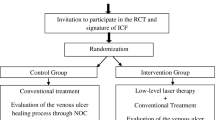Abstract
Background
Obtaining venous access in the burn population is challenging both in the acute and elective surgical settings. In paediatric burns, this is further compounded by smaller veins, thicker subcutaneous fat and poor cooperation. The introduction of infrared technology (Accuvein®) to identify veins up to 10 mm deep has been shown to increase efficacy. It has been promoted in challenging cases. We aim to ascertain whether Accuvein® is a useful clinical tool in the context of burns population.
Methods
A formal service evaluation of the device was carried out prospectively during a 6-week period. User feedback questionnaires were circulated. We reviewed patient demographics, indication of use, number of attempts and skin quality. We rated user satisfaction using visual analogue scales and a free text comment section.
Results
Twenty-eight questionnaires were returned. We noted inclination for use of device in paediatric patients compared to adults. Ethnicity included Caucasian, Asians, Afro-Caribbean and Hispanic. Skin quality in majority was described as normal; only four patients had poor quality skin (burn scars, friable thin skin). Fifteen patients had successful first attempts. Ninety-six percent of practitioners felt that the device was useful, although 59 % required assistance initially. We noted that it was not useful in detecting veins through grafted burn sites.
Conclusions
Accuvein® is a useful adjunct for venous access particularly in the paediatric population. By reducing the number of attempts to obtain venous access, this saves time and improve efficacy of care. However, we noted that it is not helpful over grafted burn sites. This could be attributable to the nature of the initial burn surgery (tangential excision) rather than the thickness of overlying skin.
Level of Evidence: Level IV, risk/prognostic study.



Similar content being viewed by others
References
Kaddoum RN, Anghelescu DL, Parish ME, Wright BB, Trujillo L, Wu J, Wu Y, Burgoyne LL (2012) A randomized controlled trial comparing the AccuVein AV300 device to standard insertion technique for intravenous cannulation of anesthetized children. Pediatr Anesth 22(9):884–889
Graaff JC, Cuper NJ, Mungra RAA, Vlaardingerbroek K, Numan SC, Kalkman CJ (2013) Near-infrared light to aid peripheral intravenous cannulation in children: a cluster randomised clinical trial of three devices. Anaesthesia 68(8):835–845
Frame F, George S, Hong J et al. (2012) An audit of peripheral intravenous cannulation technique in the emergency department: recommendations for clinical practice. Poster presentation at the Royal Medical Society’s National Student Conference in Edinburgh
Crowley M, Brim C, Proehl J, Barnason S, Leviner S, Lindauer C, Naccarato M, Storer A, Williams J, 2011 ENA Emergency Nursing Resources Development Committee. (2012) Emergency nursing resource: difficult intravenous access. J Emerg Nurs 38(4):335–343
van der Woude OCP, Cuper NJ, Getrouw C, Kalkman CJ, de Graaff JC (2013) The effectiveness of a near-infrared vascular imaging device to support intravenous cannulation in children with dark skin color: a cluster randomized clinical trial. Anesth Analg 116(6):1266–1271
Acknowledgments
We would like to thank Mr Craig Whittaker from Q Medical for loaning the device during the trial period.
Author information
Authors and Affiliations
Corresponding author
Ethics declarations
Conflict of interest
Metin Nizamoglu, Alethea Tan, Helen Gerrish, David Barnes, and Prof. Peter Dziewulski declare that they have no conflict of interest.
Patient consent
Patients provided written consent for the use of their images.
Ethical standards
For this type of retrospective study formal consent from a local ethics committee is not required.
Funding
There was no funding received for this work.
Rights and permissions
About this article
Cite this article
Nizamoglu, M., Tan, A., Gerrish, H. et al. Infrared technology to improve efficacy of venous access in burns population. Eur J Plast Surg 39, 37–40 (2016). https://doi.org/10.1007/s00238-015-1165-3
Received:
Accepted:
Published:
Issue Date:
DOI: https://doi.org/10.1007/s00238-015-1165-3




